

The Numbering Plan E.164" The E.164 recommendation, also called the "international public telecommunications numbering plan," was first approved and published by the ITU-T in May 1997.
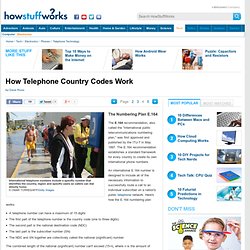
The E.164 recommendation establishes a standard framework for every country to create its own international phone numbers. TelecomSpace. Global system for mobile communication (GSM) is a globally accepted standard for digital cellular communication.
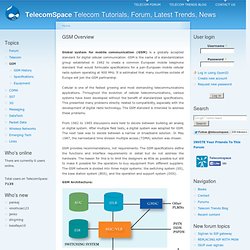
GSM is the name of a standardization group established in 1982 to create a common European mobile telephone standard that would formulate specifications for a pan-European mobile cellular radio system operating at 900 MHz. It is estimated that many countries outside of Europe will join the GSM partnership. Cellular is one of the fastest growing and most demanding telecommunications applications. Throughout the evolution of cellular telecommunications, various systems have been developed without the benefit of standardized specifications. This presented many problems directly related to compatibility, especially with the development of digital radio technology. From 1982 to 1985 discussions were held to decide between building an analog or digital system.
GSM provides recommendations, not requirements. General Packet Radio Service. General packet radio service (GPRS) is a packet oriented mobile data service on the 2G and 3G cellular communication system's global system for mobile communications (GSM).
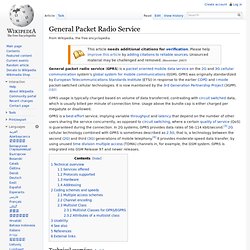
GPRS was originally standardized by European Telecommunications Standards Institute (ETSI) in response to the earlier CDPD and i-mode packet-switched cellular technologies.
Roaming. Roaming helps ensure that a traveling wireless device (typically a cell phone) is kept connected to a network without breaking the connection.
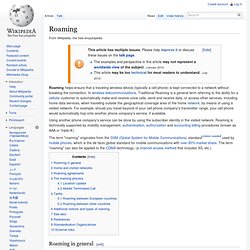
In wireless telecommunications, Traditional Roaming is a general term referring to the ability for a cellular customer to automatically make and receive voice calls, send and receive data, or access other services, including home data services, when travelling outside the geographical coverage area of the home network, by means of using a visited network. For example; should you travel beyond of your cell phone company's transmitter range, your cell phone would automatically hop onto another phone company's service, if available. The term "roaming" originates from the GSM (Global System for Mobile Communications) standard[citation needed] used by mobile phones, which is the de facto global standard for mobile communications with over 80% market share. Roaming in general[edit] Home and visited networks[edit]
Telecommunications billing. Telecommunications billing is the group of processes of communications service providers that are responsible to collect consumption data, calculate charging and billing information, produce bills to customers, process their payments and manage debt collection.[2] Telecommunications billing system is an enterprise application software designed to support the telecommunications billing processes.

Telecommunications billing is a significant component of any commercial communications service provider regardless specialization: telephone, mobile wireless communication, VoIP companies, mobile virtual network operators, internet service providers, transit traffic companies, cable and satellite TV companies could not operate without billing, because it creates an economic value of their business. Telecommunications billing functions[edit] Billing functions can be grouped to three areas: operations, information management, financial management. Operations[edit] Telecommunications mediation. Telecommunications mediation is a process that converts call data to pre-defined layout that can be imported by a specific billing system or other OSS applications.
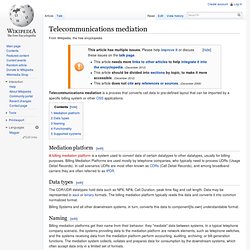
Mediation platform[edit] A billing mediation platform is a system used to convert data of certain datatypes to other datatypes, usually for billing purposes. Telecommunications rating. In telecommunications rating is the activity of determining the cost of a particular call.[1] The rating process involves converting call-related data into a monetary-equivalent value.
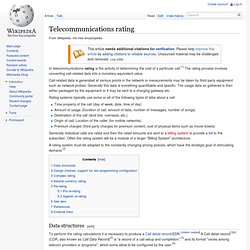
Call-related data is generated at various points in the network or measurements may be taken by third party equipment such as network probes. Generally this data is something quantifiable and specific. The usage data so gathered is then either packaged by the equipment or it may be sent to a charging gateway.etc. Service switching point. In telephony, a service switching point (SSP) is the telephone exchange that initially responds, when a telephone caller dials a number, by sending a query to a central database called a service control point (SCP) so that the call can be handled.
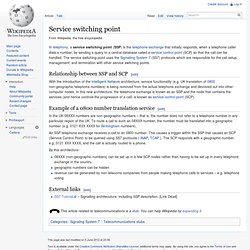
The service switching point uses the Signalling System 7 (SS7) protocols which are responsible for the call setup, management, and termination with other service switching points. Relationship between SSP and SCP[edit] With the introduction of the Intelligent Network architecture, service functionality (e.g. Service control point. A service control point (SCP) is a standard component of the Intelligent Network (IN) telephone system which is used to control the service.
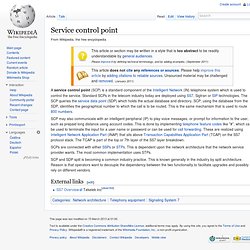
Standard SCPs in the telecom industry today are deployed using SS7, Sigtran or SIP technologies. The SCP queries the service data point (SDP) which holds the actual database and directory. SCP, using the database from the SDP, identifies the geographical number to which the call is to be routed. ISDN User Part. The ISDN User Part or ISUP is part of the Signalling System No. 7 (SS7) which is used to set up telephone calls in the public switched telephone network (PSTN).
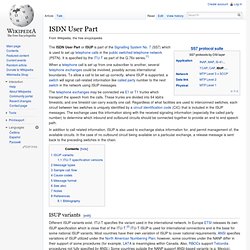
It is specified by the ITU-T as part of the Q.76x series.[1] When a telephone call is set up from one subscriber to another, several telephone exchanges could be involved, possibly across international boundaries. To allow a call to be set up correctly, where ISUP is supported, a switch will signal call-related information like called party number to the next switch in the network using ISUP messages. Multi-user MIMO. In radio, multi-user MIMO (MU-MIMO) is a set of advanced MIMO (pronounced mee-moh or my-moh), multiple-input and multiple-output, technologies where the available antennas are spread over a multitude of independent access points and independent radio terminals - each having one or multiple antennas.
In contrast, single-user MIMO considers a single multi-antenna transmitter communicating with a single multi-antenna receiver. To enhance the communication capabilities of all terminals, MU-MIMO applies an extended version of space-division multiple access (SDMA) to allow multiple transmitters to send separate signals and multiple receivers to receive separate signals simultaneously in the same band. PU2RC is a fundamental and practical MU-MIMO technology for broadcast and multiple access wireless communications. Like the relationship between OFDM and OFDMA, MU-MIMO (and, similarly, SDMA) can be thought of as an extension of MIMO applied in various ways as a multiple access strategy.
4G. 4G, short for fourth generation, is the fourth generation of mobile telecommunications technology succeeding 3G. A 4G system, in addition to usual voice and other services of 3G system, provides mobile ultra-broadband Internet access, for example to laptops with USB wireless modems, to smartphones, and to other mobile devices. Even though 4G is a successor technology of 3G, there can be signification issues on 3G network to upgrade to 4G as many of them were not built on forward compatibility. Conceivable applications include amended mobile web access, IP telephony, gaming services, high-definition mobile TV, video conferencing, 3D television, and cloud computing.
Mobile World Live. Mobile Europe - news, analysis and opinion from across the wireless industry. Billing and OSS World: A telecom billing systems and OSS magazine. Home - VanillaPlus - Driving Profits for Communication Service Providers - CSPs, OSS/BSS. Billing Standards. The GSM Association is continually driving to extend and enhance the range and diversity of international services for telecoms customers of the world. As an important part of this, the Association introduces TAP3 as the new world class standard for the billing of data. The world’s telecommunications operators are preparing for the exchange of increasingly complex and diverse billing data, to deal with vast array future wireless/fixed services.
To manage these changes and developments operators are ensuring they are fully prepared for the new worldwide industry standard for the exchange of billing information. SS7 – BackBone of Mobile Networks. SS7, the backbone of mobile networks. It is the protocol and makes mobile telephony work. SS7 is the protocol that makes communication between network entities possible. Signalling System No. 7. It is usually referenced as Signalling System No. 7 or Signalling System #7, or simply abbreviated to SS7. In North America it is often referred to as CCSS7, an abbreviation for Common Channel Signalling System 7. In some European countries, specifically the United Kingdom, it is sometimes called C7 (CCITT number 7) and is also known as number 7 and CCIS7 (Common Channel Interoffice Signaling 7).
In Germany it is often called N7 (Signalisierungssystem Nummer 7). There is only one international SS7 protocol defined by ITU-T in its Q.700-series recommendations.[1] There are however, many national variants of the SS7 protocols. Most national variants are based on two widely deployed national variants as standardized by ANSI and ETSI, which are in turn based on the international protocol defined by ITU-T. The Internet Engineering Task Force (IETF) has also defined level 2, 3, and 4 protocols that are compatible with SS7: Intelligent Network. The Intelligent Network (IN) is the standard network architecture specified in the ITU-T Q.1200 series recommendations. Frequency-division multiplexing. The most natural example of frequency-division multiplexing is radio and television broadcasting, in which multiple radio signals at different frequencies pass through the air at the same time.
Another example is cable television, in which many television channels are carried simultaneously on a single cable. FDM is also used by telephone systems to transmit multiple telephone calls through high capacity trunklines, communications satellites to transmit multiple channels of data on uplink and downlink radio beams, and broadband DSL modems to transmit large amounts of computer data through twisted pair telephone lines, among many other uses. Wavelength-division multiplexing. Code division multiple access. Time division multiple access. This article is about the channel access method. Universal Mobile Telecommunications System. GPRS core network. The GPRS core network is the central part of the general packet radio service (GPRS) which allows 2G, 3G and WCDMA mobile networks to transmit IP packets to external networks such as the Internet. Base station subsystem.
Base transceiver station[edit] Two GSM base station antennas disguised as trees in Dublin, Ireland. Network switching subsystem. Summit Programme. Mobile Roaming Forum Africa. Johannesburg, South Africa “The world gets wider: roam the world with your mobile”